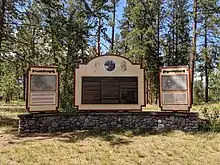Hellgate treaty
The Treaty of Hellgate was signed in Hellgate on July 16, 1855 between Indian commissioner Isaac Stevens and the Native American tribes located in western Montana. The treaty was ratified by Congress, signed by President James Buchanan, and proclaimed on April 18, 1859.[1]

Description
The tribes involved in the signing of the treaty were the Bitterroot Salish, Pend d'Oreille, and the Kootenai. The tribes negotiated the Hellgate treaty with the United States in 1855. Based on the terms of the accord, the Native Americans were to relinquish their territories to the United States government in exchange for payment installments that totaled $120,000 dollars. The territories in question entailed everything from the main ridge of the Rocky Mountains at the 49th parallel to the Kootenai River and Clark Fork to the divide between the St. Regis River and the Coeur d'Alene River. From there, the ceded territories also extend to the southwestern fork of the Bitterroot River and up to Salmon River and Snake River.
The Flathead Indian Reservation was established by the treaty. Flathead Lake lies in the northeast corner of the reservation, with most of the reservation to the south and west of the lake.
The treaty was ratified on March 8, 1859.
Observations
A Jesuit observer, Father Adrian Hoecken, said that the translations were so poor that "not a tenth of what was said was understood by either side".
See also
References
- Prucha, Francis Paul (1994). American Indian Treaties: The History of a Political Anomaly. University of California Press. ISBN 0-520-20895-1.